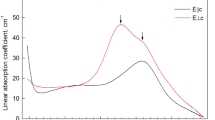Abstract
THE investigations hitherto made have shown that three band systems belong with certainty to the strontium oxide molecule (SrO); the first of these is situated in the infra-red, the second in the blue and the third in the ultra-violet region. Mahanti made vibrational analyses of the blue and ultra-violet systems1. A vibrational and rotational analysis of the infra-red system, a 1Σ – 1Σ transition, was communicated by us in 19492. This analysis shows that the vibrational frequencies of the lower 1Σ state coincide extremely well with those of the lower state of the blue system. Thus for 1Σ we found ω″e = 653.49 and x″eω″e = 4.00, as compared with 653.47 and 4.02 for the lower state of the blue system. In our paper we mentioned this agreement and assumed that the infra-red and blue systems have the same lower state. Recently, Budó and Kovács have privately communicated to us that they have made a successful rotational analysis of the blue bands. The transition is 1Π – 1Σ, where the lower state is the same as for the infra-red bands.
Similar content being viewed by others
References
Mahanti, P. C., Phys. Rev., 42, 609 (1931).
Almkvist, G., and Lagerqvist, A., Arkiv för Fysik, 1, 477 (1949).
Author information
Authors and Affiliations
Rights and permissions
About this article
Cite this article
ALMKVIST, G., LAGERQVIST, A. Ultra-Violet Band System of Strontium Oxide (SrO). Nature 170, 885–886 (1952). https://doi.org/10.1038/170885a0
Issue Date:
DOI: https://doi.org/10.1038/170885a0
- Springer Nature Limited
This article is cited by
-
Rotationsanalyse Einiger Blauen Banden des SrO-Moleküls
Acta Physica Academiae Scientiarum Hungaricae (1953)





